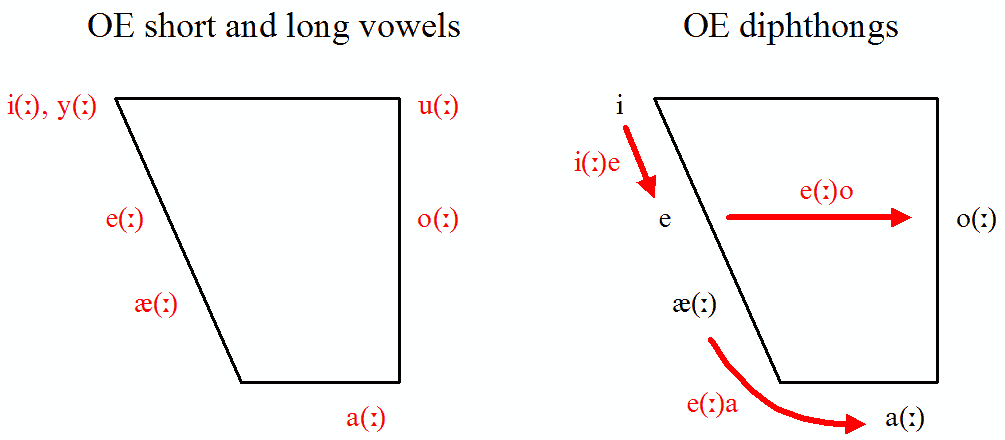古英語の母音には,短母音 (short vowel),長母音 (long vowel),二重母音 (diphthong) の3種類が区別される.二重母音にも短いものと長いものがある.以下,左図が短・長母音を,右図が短・長の二重母音を表わす.

左図の短・長母音からみていくと,現代英語に比べれば,区別される母音分節音の種類(音素)は少ない (cf. 「#1601. 英語と日本語の母音の位置比較」 ([2013-09-14-1])).長母音は対応する短母音の量をそのまま増やしたものであり,音価の違いはないものと考えられている.前舌高母音には平唇の i(ː) と円唇の y(ː) が区別されるが,円唇 y(ː) は後期ウェストサクソン方言 (Late West-Saxon) では平唇化して i(ː) となった.
次に右図の二重母音をみると,音量を別にすれば,3種類の二重母音があることがわかる.i(ː)e, e(ː)o, æ(ː)a は,いずれも上から下あるいは前から後ろという方向をもっており,第1要素が第2要素よりも強い下降二重母音 (falling diphthong) と考えられる.ただし,i(ː)e については,二重母音ではなく i と e の中間的な母音を表わしていたとする見解もある.Mitchell and Robinson (15) の注によると,
The original pronunciation of ie and īe is not known with any certainty. It is simplest and most convenient for our purposes to assume that they represented diphthongs as explained above. But by King Alfred's time ie was pronounced as a simple vowel (monophthong), probably a vowel somewhere between i and e; ie is often replaced by i or y, and unstressed i is often replaced by ie, as in hiene for hine. Probably īe had a similar sound.
古英語期中の音変化も考慮するといくつかの但し書きは必要となるが,上の図に従えば,(7単音×短・長2系列)+(3二重母音×短・長2系列)ということで計20ほどの母音が区別されていたことになる.「#1021. 英語と日本語の音素の種類と数」 ([2012-02-12-1]) でみたように,現代英語の標準変種でも20の母音音素が区別されているから,数の点からいえば古英語の母音体系もおよそ同規模だったことになる.
・ Mitchell, Bruce and Fred C. Robinson. A Guide to Old English. 8th ed. Malden, MA: Wiley-Blackwell, 2012.